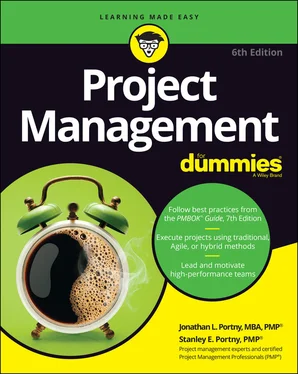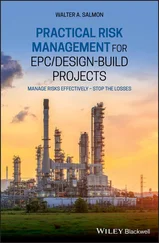Encourage your team members to brainstorm possible stakeholders before you show them an existing stakeholder register template. Encouraging people to identify stakeholders without guidance or restrictions increases the chances that they’ll think of stakeholders who were overlooked on previous projects.
Use templates as starting points, not ending points. Make clear to your team that the template isn’t the final register. Every project differs in some ways from similar ones. If you don’t critically examine the template, you may miss people who weren’t involved in previous projects but whom you need to consider for this one.
Reflect your different project experiences in your stakeholder register templates. The post-project evaluation is an excellent time to review, critique, and modify your stakeholder register for a particular project (see Chapter 17for details on the post-project evaluation).
 Templates can save time and improve accuracy. However, starting with a template that’s too polished can suggest you’ve already made up your mind about the contents of your final list, which may discourage people from freely sharing their thoughts about other potential stakeholders. In addition, their lack of involvement in the development of the project’s audience list may lead to their lack of commitment to the project’s success.
Templates can save time and improve accuracy. However, starting with a template that’s too polished can suggest you’ve already made up your mind about the contents of your final list, which may discourage people from freely sharing their thoughts about other potential stakeholders. In addition, their lack of involvement in the development of the project’s audience list may lead to their lack of commitment to the project’s success.
Determining Whether Stakeholders Are Drivers, Supporters, or Observers
After you identify every one of your stakeholders, you need to determine which of the following groups those people fall into. Then you can decide whether to involve them and, if so, how and when:
Drivers: People who have some say in defining the results of your project. You’re performing your project for these people.
Supporters: The people who help you perform your project. Supporters include individuals who authorize or provide the resources for your project as well as those who actually work on it.
Observers: People who are neither drivers nor supporters but who are interested in the activities and results of your project. Observers have no say in your project, and they’re not actively involved in it. However, your project may affect them at some point in the future.
Separating stakeholders into these three categories helps you decide what information to seek from and share with each group, as well as to clarify the project decisions in which to involve them.
Suppose an IT group has the job of modifying the layout and content of a monthly sales report for all sales representatives. The vice president of sales requested the project, and the chief information officer (CIO — the head of IT’s manager) approved it. As the project manager for this project, consider categorizing your project’s stakeholders as follows:
Drivers: The vice president of sales is a driver because they have specific reasons for revising the report. The CIO is a potential driver because they may hope to develop certain new capabilities for their group through this project. Individual sales representatives are all drivers for this project because they’ll use the redesigned report to support their work.
Supporters: The systems analyst who designs the revised report, the training specialist who trains the users, and the vice president of finance who authorizes the funds for changing the manual are all supporters.
Observers: The head of the customer service department is a potential observer because they hope your project will lead to an improved problem-tracking system this year.
 Beware of supporters who try to act like drivers. In the preceding example, the analyst who finalizes the content and format of the report may try to include certain items that they think are helpful. However, only the real drivers should determine the specific data that go into the report. The analyst just determines whether including the desired data is possible and what doing so will cost.
Beware of supporters who try to act like drivers. In the preceding example, the analyst who finalizes the content and format of the report may try to include certain items that they think are helpful. However, only the real drivers should determine the specific data that go into the report. The analyst just determines whether including the desired data is possible and what doing so will cost.
 Keep in mind that the same person can be both a driver and a supporter. For example, the vice president of sales is a driver for the project to develop a revised monthly sales report, but they are also a supporter if they have to transfer funds from the sales department budget to pay for developing the report.
Keep in mind that the same person can be both a driver and a supporter. For example, the vice president of sales is a driver for the project to develop a revised monthly sales report, but they are also a supporter if they have to transfer funds from the sales department budget to pay for developing the report.
The following sections help you identify when you need to involve drivers, supporters, and observers, and how to keep them involved.
INCLUDING A PROJECT CHAMPION
A project champion (or project sponsor ) is a person in a high position in the organization who strongly supports your project; advocates for your project in disputes, planning meetings, and review sessions; and takes whatever actions are necessary to help ensure the successful completion of your project.
As soon as you start planning, find out whether your project has a champion. If it doesn’t, try to recruit one. An effective project champion has the following characteristics:
Sufficient power and authority to resolve conflicts over resources, schedules, and technical issues
A keen interest in the results of your project
A willingness to have their name cited as a strong supporter of your project
Deciding when to involve your stakeholders
Projects pass through the following four phases as they progress from an idea to completion (see Chapter 1for detailed explanations of these phases):
Starting the project
Organizing and preparing
Carrying out the work
Closing the project
Plan to involve drivers, supporters, and observers in each phase of your project’s life cycle. The following sections tell you how you can do so. See the later section “ Assessing Your Stakeholders’ Power and Interest” for information on what to consider when deciding how to involve different stakeholders.
Keeping drivers involved in your project from start to finish is critical because they define what your project should produce, and they evaluate your project’s success when it’s finished. Their desires and your assessment of feasibility can influence whether you should pursue the project. Check out Table 4-1to see how to involve drivers during the four phases of your project.
Involving supporters from start to finish is important since they perform and support the project work; supporters need to know about changing requirements so they can promptly identify and address problems. Keeping them actively involved also sustains their ongoing motivation and commitment to the project. Check out Table 4-2to see how to involve supporters during your project’s four phases.
After you choose the observers with whom you want to actively share project information, involve them minimally throughout the project because they neither tell you what should be done nor help you do it. Table 4-3shows how you may keep observers involved.
TABLE 4-1Involving Drivers in the Different Project Phases
| Phase |
Involvement Level |
How to Involve |
| Starting the project |
Heavy |
Identify and speak with as many drivers as possible. If you uncover additional drivers later, explore with them the issues that led to the project; ask them to identify and assess any special expectations they may have. |
| Organizing and preparing |
Moderate to heavy |
Consult with drivers to ensure your project plan addresses their needs and expectations. Have them formally approve the plan before you start the actual project work. |
| Carrying out the work |
Moderate |
As the project gets underway, introduce the drivers to the project team. Have the drivers talk about their needs and interests to reinforce the importance of the project and help team members form a more accurate picture of project goals. In addition, have the team members talk to the drivers to increase the drivers’ confidence that the team members can successfully complete the project. While performing the project work, keep drivers apprised of project accomplishments and progress to sustain their ongoing interest and enthusiasm. Continually confirm that the results are meeting their needs. |
| Closing the project |
Heavy |
Have drivers assess the project’s results and determine whether their needs and expectations were met. Identify their recommendations for improving performance on similar projects in the future. |
TABLE 4-2Involving Supporters in the Different Project Phases
Читать дальше

 Templates can save time and improve accuracy. However, starting with a template that’s too polished can suggest you’ve already made up your mind about the contents of your final list, which may discourage people from freely sharing their thoughts about other potential stakeholders. In addition, their lack of involvement in the development of the project’s audience list may lead to their lack of commitment to the project’s success.
Templates can save time and improve accuracy. However, starting with a template that’s too polished can suggest you’ve already made up your mind about the contents of your final list, which may discourage people from freely sharing their thoughts about other potential stakeholders. In addition, their lack of involvement in the development of the project’s audience list may lead to their lack of commitment to the project’s success. Keep in mind that the same person can be both a driver and a supporter. For example, the vice president of sales is a driver for the project to develop a revised monthly sales report, but they are also a supporter if they have to transfer funds from the sales department budget to pay for developing the report.
Keep in mind that the same person can be both a driver and a supporter. For example, the vice president of sales is a driver for the project to develop a revised monthly sales report, but they are also a supporter if they have to transfer funds from the sales department budget to pay for developing the report.










